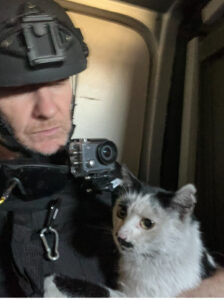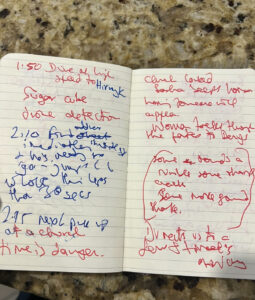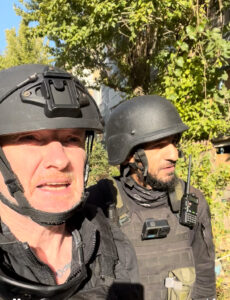Local Volunteers in Ukraine Giving Hope and Saving Lives
By Brian Dooley
 Lately, more of my work in Ukraine for Human Rights First, involves joining local volunteers in evacuating civilians from the front line.
Lately, more of my work in Ukraine for Human Rights First, involves joining local volunteers in evacuating civilians from the front line.
Although it’s not what I spend most of my time doing, it’s what I’m most often asked about, with people wanting to know how it’s done, who gets evacuated, and the risks involved.
So here’s a rundown of a day in October of 2024 where I joined a local activists Sasha Humaniuk and Daniel Zakharchenko of the Kharkiv-based Roza na Ruke (Rose on Hand) volunteer group to evacuate civilians living in villages under fire.
Getting organized for the day begins the night before, checking and rechecking equipment – flak jacket, helmet, emergency medical kit with tourniquets, bandages, scissors, tampons (for bullet wounds), packing gauze and various other things in case someone is hit.
We went to Donetsk, to the small city of Pokrovsk and surrounding settlements, about 150 miles south of the city of Kharkiv. The Russian military had been making steady advances in this area in the weeks before, and claimed to have already taken some of the villages we were heading for, including Selydove and Hirnyk.
Many civilians, often elderly, want to escape these battlefront villages, and rely on volunteer evacuation teams to rescue them. The shelling is constant. Russian and Ukrainian soldiers battle in these villages street by street, and control of neighborhoods can change from hour to hour. A few weeks before we went Sasha and Daniel had been confronted by a Russian soldier here as they were evacuating elderly people, and they were mercifully allowed to leave.
Sasha texted me that night: “Hi Brian, today was a very busy day. We were hit by a drone, it exploded, we were in an armored car and then we ran into a Russian soldier, thank God he didn’t kill us, he let us go and let us get three people out…[in all today] 20+ people were taken out.”
On Tuesday, October 1, we set out early for the long day ahead.
3:00am – Leave Kharkiv City in a Roza na Ruke van for the drive to Pokrovsk.
8:05am – Arrive in Pokrovsk. Sasha explains we are first going to the village of Selydove. “It’s 50-50 Russian and Ukrainian controlled,” he says. A woman has called from there and asked to be evacuated.
9:15am – Arrive at Selydove, and find Angela at her home; she is packed and almost ready go. As she prepares to leave, we run along the street banging on doors and looking into basement shouting “Evacuatsi” in case anyone wants to make a last-minute decision to come with us and escape, but everywhere is empty.
9:25am – Explosions around us. Rescue a street cat and take him with us.
10:45am – Leave Angela at local center for evacuated villagers at nearby settlement of Kurakhove. This is also a village under fire, but marginally safer, a few miles from the fighting. Those evacuated from the most intense danger are gathered here and moved out later in the day. We agree to take two other elderly women who show up here and explain we will drive them out later.
11:25am – 12:15pm – Arrive at village of Kurakhivka, but can’t find the address of the elderly woman who wants to be evacuated. As usual, we park the van under a tree to avoid detection by drones, but the longer we linger the more chance we will be spotted. Eventually, we find Lydia, but there is a problem.
 She is with her son who refuses to leave with her. At 56 years old, if he is evacuated to safety he is liable to be put into the Ukrainian army. His choice is between staying in a village under heavy fire, which could be taken imminently by Russian soldiers, and taking his chance on being conscripted into the Ukrainian military. He doesn’t look the warrior type, and a fraught 20 minutes pass with the mother and son in tearful argument.
She is with her son who refuses to leave with her. At 56 years old, if he is evacuated to safety he is liable to be put into the Ukrainian army. His choice is between staying in a village under heavy fire, which could be taken imminently by Russian soldiers, and taking his chance on being conscripted into the Ukrainian military. He doesn’t look the warrior type, and a fraught 20 minutes pass with the mother and son in tearful argument.
The explosions around us seem very close as the pair stand in the street discussing what to do. We nervously scour the skies for drones as they finally decide they will both come with us. In some distress, Lydia says goodbye to her house, making elaborate religious blessings outside the front door as she walks away.
12:15pm – As we leave, a small street dog jumps into our van in a successful bid to self-evacuate.
1:30pm – Drop Lydia and her son back at the meeting place in Kurakhove.
1:50pm – Drive at high speed to the village of Hirnyk across a narrow bridge scarred and damaged by several recent missile hits.
2:10pm – Find the home of a man wanting to be evacuated. He’s packed, ready to go, and jumps into the van with a few bags and a kitten in a box. Pickup takes 30 seconds. Ideal.
2:15pm – Arrive at a nearby church in Hirnyk to fetch a woman. But the gates are closed, and waiting around is very risky. Someone appears and gives directions to a house a few streets away where the woman is waiting. More explosions around us, varying from a heavy rumble to a sharp crack. As we drive to the house our drone detector beeps—there is something flying above us. We find her, she is ready to go, bags packed, in the van and away within 60 seconds. Full speed back over the bridge at high speed, past the village of Illinka on the left, and back into Kurahkhove.
3:00pm – More people show up at the center in Kurahivka asking to be evacuated. We leave with them and those we have rescued to make our way to a prearranged pickup point.
4:45pm – We hand over those we have evacuated—nine women, two men, two dogs, and two cats—to the NGO Helping to Leave. They board a big bus and are taken away from the front line. Some will go to relatives, others will be accommodated in government-run shelters, and others will be housed by NGOs. For now, they are much safer than they were.
10:00pm – Arrive back in Kharkiv city.

Sasha, Daniel and the other volunteers in the team spend many days evacuating people at great risk to themselves. Because international NGOs and donors rarely visit the places where the evacuation teams work, much of this lifesaving activism goes unreported and unrecognized, and so it’s hard for them to get the attention needed to generate donations from overseas.
They rely on locals giving them money for gas, vehicle repairs and medical kits.
They do this work voluntarily – the strain on them is immense, and the danger extreme.
Five days after I made this trip, on Sunday October 6, the team returned to the area. This time Daniel Zakharchenko was with Tigran Galustyan. At 2:50pm Tigran was driving the van, and Daniel was next to him, on the road between the villages of Kurakhove and Hirnyk to rescue six adults and a two-month-old baby.
A Russian drone tracked the van – clearly marked as an evacuation vehicle – and fired a missile through the roof above the driver’s seat, and into Tigran. He stayed alive for a short while, but soon died from a loss of blood.
He was 37 years old, and had been volunteering with the evacuation team for nine months. He is the first member of the Roza na Ruke team to be killed. He had a six-year-old daughter.
What happened to Tigran is a constant reminder to the team of the risks they take.
In July 2025 I was back with the volunteers evacuating civilians from the frontline city of Kupiansk when a Russian drone again attacked one of our vehicles, missing it by a few feet. No-one was injured, only the back window blown out, but it was another close call.
But within a few days the volunteers were back evacuating people, saving lives, and giving hope to those stranded at the front line. Much of this sort of work goes unreported and unseen, but people all along the front line of Ukraine are helping others, often with only few resources, and at enormous risk.
Brian Dooley is a longtime human rights activist, specializing in working with human rights activists living in revolutions, wars or under severe repression. He is an Honorary Professor of Practice at Queen’s University Belfast, a Visiting Scholar at UCL in London, and Senior Advisor at Human Rights First.

